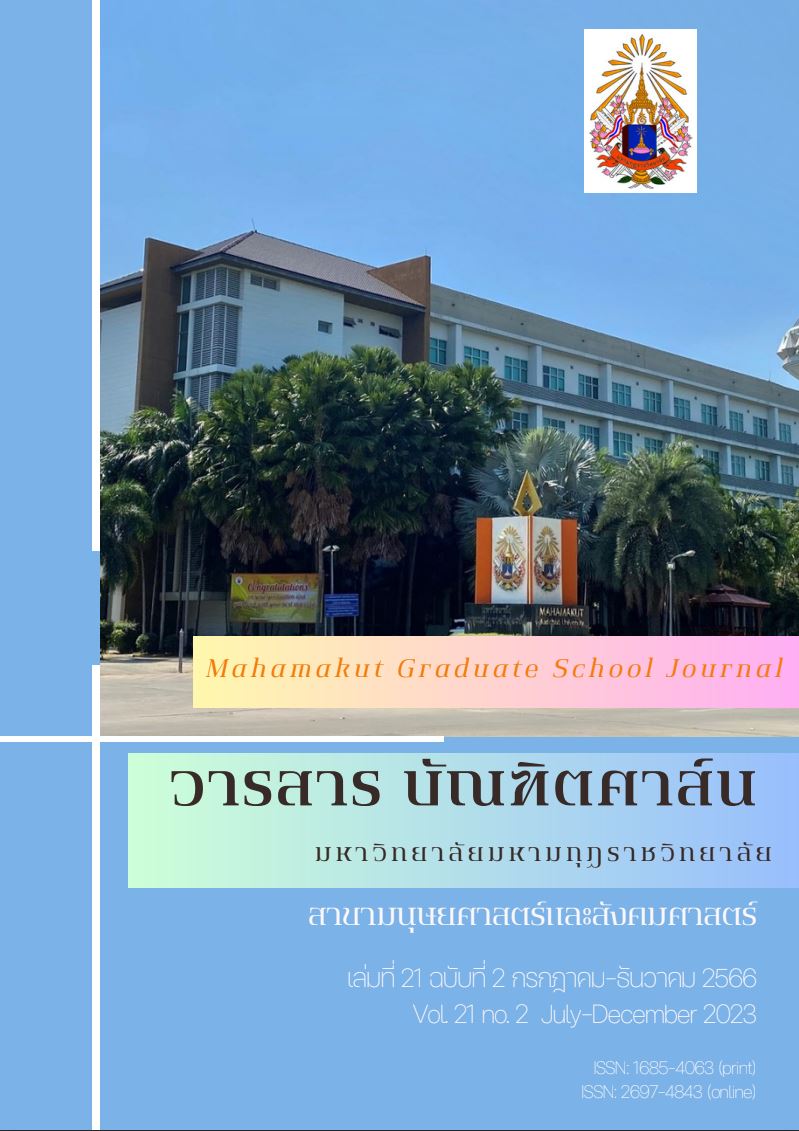อิทธิพลของพุทธชัยมังคลอัฏฐคาถาที่มีต่อสังคมไทย
คำสำคัญ:
พุทธชัยมงคลคาถา, ฎีกาพาหุง, ประติมานวิทยาบทคัดย่อ
งานวิจัยนี้มีวัตถุประสงค์เพื่อศึกษาประวัติความเป็นมาของบทพุทธชัยมงคลอัฏฐคาถา ศึกษารูปแบบและลักษณะทางประติมานวิทยาที่เกี่ยวกับบทพุทธชัยมงคลอัฏฐคาถาที่พบในประเทศไทย และศึกษาอิทธิพลของบทพุทธชัยมงคลอัฏฐคาถาที่มีต่อสังคมไทย
บทพุทธชัยมังคลอัฏฐคาถาเป็นบทสวดมนต์สำคัญที่กล่าวถึงชัยชนะอันเป็นมงคลของพระพุทธเจ้าในการปราบมนุษย์หรืออมนุษย์ด้วยธรรมวิธีต่าง ๆ 8 เหตุการณ์ บ้างเชื่อว่าเป็นบทที่แต่งขึ้นเฉพาะสำหรับพระเจ้าแผ่นดิน บ้างเชื่อว่าเป็นบทที่แต่งขึ้นเพื่อสรรเสริญแด่พระพุทธเจ้า ทั้งยังมีแนวคิดว่าบทสวดมนต์นี้แต่งขึ้นในประเทศศรีลังกาหรือในประเทศไทย หากแต่เป็นบทสวดมนต์สำคัญที่ได้รับความนิยมดังปรากฏธรรมเนียมในการสวดมนต์บทนี้สืบมาจนถึงปัจจุบัน มีคติความเชื่อในพระพุทธคุณของบทสวดมนต์ ตลอดจนมีความนิยมในการนำบทสวดมนต์บทนี้มาใช้ในการออกแบบสร้างงานพุทธศิลปกรรมสืบมาจนถึงปัจจุบัน
เอกสารอ้างอิง
ภาษาไทย
หนังสือทั่วไป
ญาณสังวร สมเด็จพระสังฆราช สกลมหาสังฆปริณายก, สมเด็จพระ. (2540). เจ็ดตำนานและสิบสองตำนานพุทธมนต์. กรุงเทพฯ: มหามกุฏราชวิทยาลัย.
ทองย้อย แสงศิลป์ชัย, น.ต. (2542). พุทธชัยมงคลคาถา (คาถาพาหุง). กรุงเทพฯ: สหธรรมิก.
ธรรมธิเบศร์, เจ้าฟ้า. (2509). พระมาลัยคำหลวง. พระนคร: มหามกุฏราชวิทยาลัย.
ธรรมสิงหบุราจารย์ (จรัญ ฐิตธมฺโม), พระ. (2550). วิถีกรรม หลวงพ่อจรัญ ฐิตธมฺโม. กรุงเทพฯ: สุภา.
พุทธชัยมงคล 8 (คำแปลบท พาหุง) (ขุนประพันธ์ เนติวุฒิและนายคำ ศาสนดิลก แปล) กับปาฐกถาเรื่อง ชัยชนะของพระพุทธเจ้า ของพันเอก ปิ่น มุทุกันต์. (2518). กรุงเทพฯ: ส.พยุงพงศ์.พระภิกษุปาลโก พิมพ์ร่วมกุศลงานพระราชทานเพลิงศพ อำมาตย์ตรี หลวงสอบถูกระบิล (เทียน เกตุนุติ) ณ เมรุวัดแก้วแจ่มฟ้า สี่พระยา วันอาทิตย์ ที่ 21 ธันวาคม 2518.
มงกุฎเกล้าเจ้าอยู่หัว, พระบาทสมเด็จพระ. (2503). คำนมัสการคุณานุคุณ. พระนคร: รุ่งนคร. พิมพ์แจกในงานทอดกฐินพระราชทาน สำนักพระราชวัง ณ วัดทรงธรรม จังหวัดสมุทรปราการ พ.ศ. 2503.
เริง อรรถวิบูลย์. (2511). ความรู้เรื่องพิธีธรรมเนียมสงฆ์ เล่ม 1. พระนคร: คุรุสภา.
สวัสดิ์ พัฒน์เกิดผล, นาวาโท. (2507). พระพุทธชัยมงคลคาถา. ธนบุรี: โรงพิมพ์กรมสารบรรณทหารเรือ.
สารานุประพันธ์ (นวล ปาจิณพยัคฆ์), หลวง. (2560). บุรุษเรืองนาม. กรุงเทพฯ: สำนักวรรณกรรมและประวัติศาสตร์ กรมศิลปากร.
สาสนโสภณ (เจริญ สุวฑฺฒโน), พระ. (2518). ประวัติคาถาชินบัญชร. กรุงเทพฯ: มหามกุฏราชวิทยาลัย.
สุภาพรรณ ณ บางช้าง. (2533). วิวัฒนาการวรรณคดีบาลีสายพระสุตตันตปิฎกที่แต่งในประเทศไทย. กรุงเทพฯ: โรงพิมพ์จุฬาลงกรณ์มหาวิทยาลัย.
เสฐียรพงษ์ วรรณปก. (2548). คาถาพาหุง: คาถาแห่งชัยชนะอันยิ่งใหญ่ของพระพุทธองค์. กรุงเทพฯ: ธรรมสภา.
วิทยานิพนธ์ และรายงานการวิจัย
อัสนี พูลรักษ์. (2555). “นันโทปนันทสูตรคำหลวง: การวิเคราะห์ศิลปะการแปลและกลวิธีทางวรรณศิลป์”, วิทยานิพนธ์ปริญญาอักษรศาสตรมหาบัณฑิต, คณะอักษรศาสตร์ จุฬาลงกรณ์มหาวิทยาลัย.
ภาษาต่างประเทศ
หนังสือทั่วไป
Webb, Russell, Nyanatusita, Bhikkhu. (2011). An Analysis of the Pali Canon and a Reference Table of Pali Literature. Kandy: Buddhist Publication Society Inc.
ดาวน์โหลด
เผยแพร่แล้ว
รูปแบบการอ้างอิง
ฉบับ
ประเภทบทความ
สัญญาอนุญาต
ลิขสิทธิ์ (c) 2024 มหาวิทยาลัยมหามกุฏราชวิทยาลัย

อนุญาตภายใต้เงื่อนไข Creative Commons Attribution-NonCommercial-NoDerivatives 4.0 International License.
บทความวิชาการและบทความวิจัยในวารสารฉบับนี้ถือเป็นความรับผิดชอบของผู้เขียนเท่านั้น บทความที่ได้รับการตีพิมพ์ในวารสารบัณฑิตศาส์น ถือเป็นลิขสิทธิ์ของมหาวิทยาลัยมหามกุฏราชวิทยาลัย ตามพระราชบัญญัติลิขสิทธิ์



